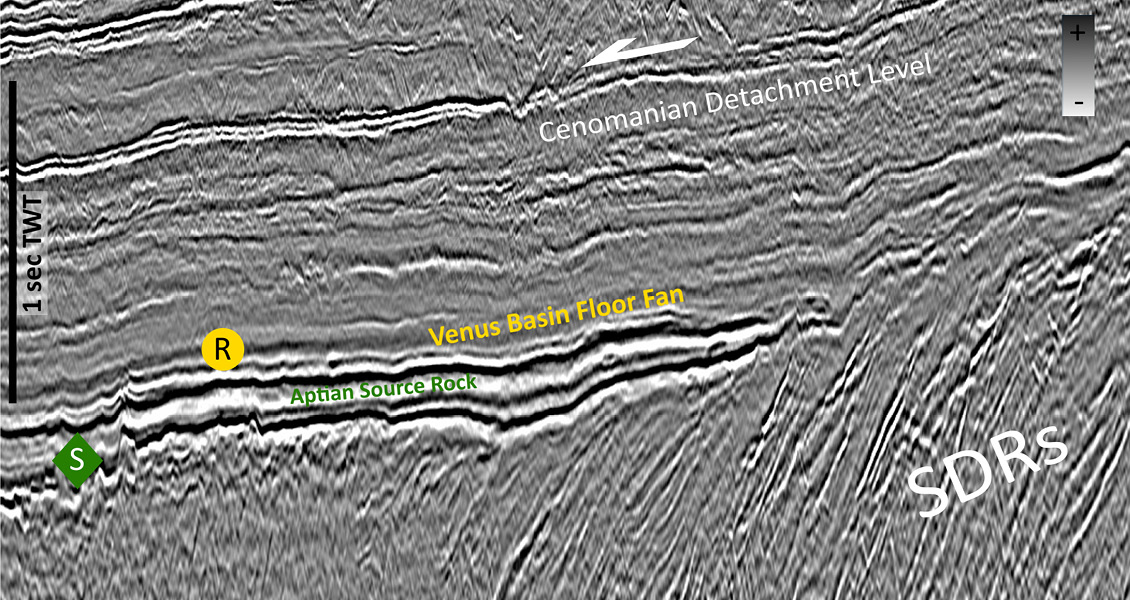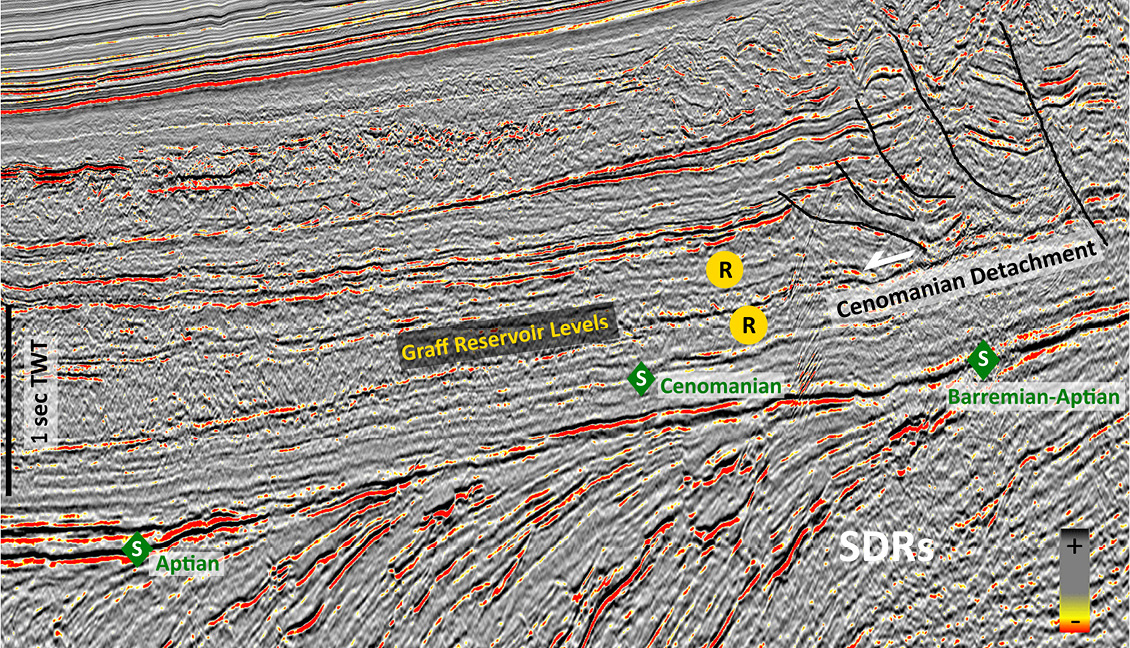
The Orange Basin – An underexplored oil giant?
The Orange Basin offshore Namibia and South Africa
The Orange Basin is part of the volcanic-rifted passive margin south of the Walvis Volcanic Ridge along the southern South Atlantic coast of Namibia and South Africa. The basin formed in the Late Jurassic to Early Cretaceous period, as South America and Africa started to rift apart, forming continental syn-rift half-graben. The Orange Basin can be divided into two major sub-basins separated by the Outer High basement ridge (Foldout), thick subaerial flood basalts that form a large area of Seaward Dipping Reflectors (SDRs) measuring more than 5 km thickness The inner sub-basin formed first, in a NW–SE direction, possibly in the Neocomian era. The outer sub-basin formed later, during the Aptian, with the submersion of the SDRs. The rifting provided an environment for the young South Atlantic Ocean where circulation was restricted creating anoxic marine conditions in the Barremian to Aptian eras, allowing good quality source rock facies to develop and deposit under anaerobic conditions. In the inner sub-basin, they are referred to as the Kudu Shale Formation.
Hydrocarbon play concepts offshore Namibia and South Africa
The Venus discovery is in the outer sub-basin, as shown in a seismic dip line in Figure 1. The trapping mechanism of Venus is the basin floor fan fairway onlapping onto the Outer High. The Outer High plays an important part in controlling reservoir and source rock distribution and deposition and is also responsible for generating many other trapping configurations. Barremian-aged carbonates inboard drowned out during the sag phase but formed carbonate platforms on the Outer High. These can also be reservoirs in the form of shallow marine bioclastic limestones, build-ups, and shoals. The Venus reservoir Aptian sands were probably sourced from the inboard basin in the east and transported across the carbonate platform on the Outer High, to be deposited in the outer sub-basin, ponding in the accommodation space down-dip. The Shell-operated Graff-1 discovery in the inner sub-basin, shown on Figure 2, is of Late Cretaceous age (possibly Campanian to Santonian) and is buried approximately 2.5 km below mudline. The trap appears to be a stratigraphic sub-thrust trap developed at the outboard extent of the Late Cretaceous toe-thrust structures – which developed due to episodic gravitational collapse along the margin. The Outer High has probably played an important role for this trap, acting as a backstop causing turbidite sands to pond east of the High. The Outer High also seems to control the westerly extent of the Late Cretaceous toe-thrust imbricates. Some untested plays are the compressional toe-thrust structures of the Orange Basin’s gravitationally driven system and the large roll-over structures of the extensional domain inboard of the same gravity-driven system (Foldout).
Source rock presence and maturation modelling
Interpretation of regional seismic data and well information along the Namibia and South Africa margin suggests that the Barremian–Aptian source rock is distributed over wide parts of offshore Namibia, as far north as the Walvis Ridge, and southwards into South Africa. The source rock thickness is varying across the two main sub-basin depocentres, which are divided by the Outer High. The Barremian–Aptian restricted marine source rock which was encountered in previous exploration wells has a varied Total Organic Carbon between 1% and 14%, the control of which is suggested to be the dilution with differing clastics inboard and better distal organic content outboard. Overall, based on the available data, the best oil-prone source rock seems most likely to be present in the outer sub-basin and at the western edge of the inner sub-basin where it is less likely to be diluted with shelf-derived clastics. 1D basin modelling at several well and pseudo-well locations offshore Namibia and South Africa based on regional well-tied seismic surfaces, a continental crust rift temperature model and a Miocene heating event in the Orange Basin (Vema hotspot) corroborate a Late Cretaceous start of oil generation on the western flanks with most of the kerogen converted to oil by mid-Tertiary times. The wider basin modelling study, now tied in with the oil window from the Venus discovery, indicates favourable burial history for oil expulsion in the outboard, not only for the Orange Basin, but in the Lüderitz and Walvis basins along the equivalent fairway trend. Mapping the kitchens and the discoveries’ amplitude versus offset anomalies is key to understanding the play fairways of the recent discoveries, and more importantly how each play concept works. Important next steps are mapping the Aptian interval west of the Outer High for fan geometries and finding channels that cut across the carbonate platform to identify where Venus lookalikes may exist in other parts of Namibia, as well as mapping out and modelling the maturity of the underlying Barremian–Aptian and Cenomanian–Turonian source rocks outboard and inboard of the Outer High. There will be many prospective ponded sand bodies equivalent to the Venus trap type and Graff lookalikes found along the length of the Namibian and South African outboard fairway, surrounded by Aptian source rock, which is likely in the oil window.






